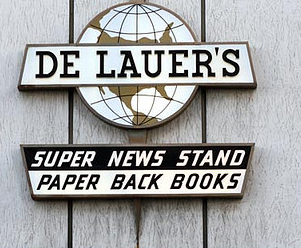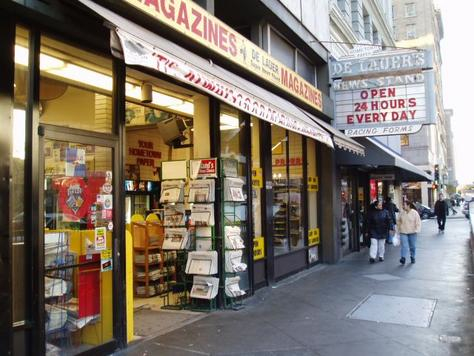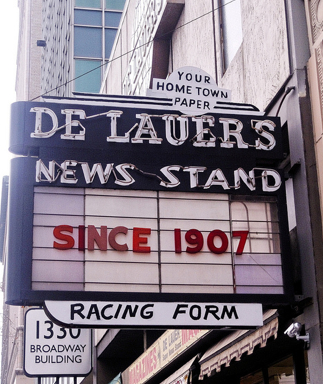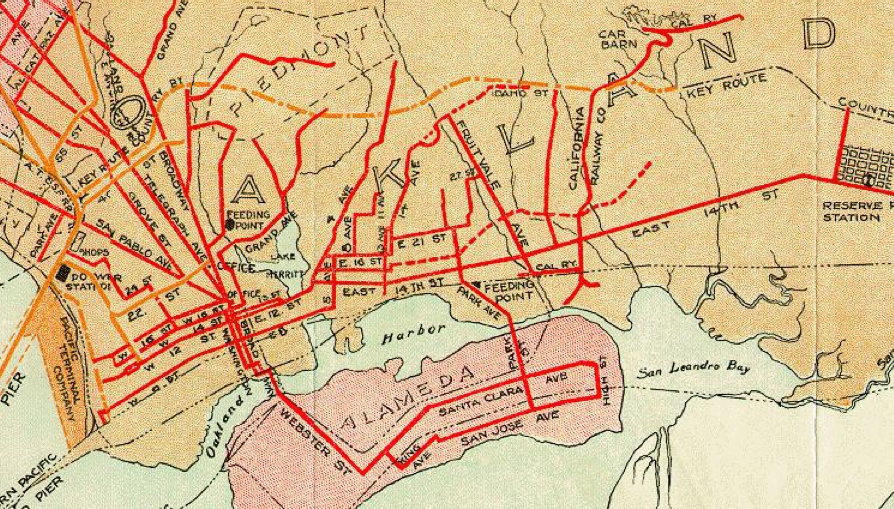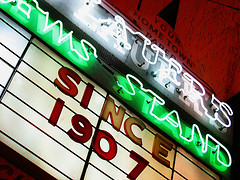There are multiple layers of nostalgia in the antique map once found in the familiar marquee of De Lauer’s Super News Stand in downtown Oakland, California. The sign was long an emblem a comprehensive range of world news sources and foreign newspapers, the dated map as a relic of an old sense of news. The map that so dramatically foregrounded the prominence of the United States in such an exaggerated fashion is both heavy with nostalgia of a past sense of the global centrality of north America in world news, and also of a time when the news was able to be mapped or derived from different fixed news bureaus, and bridged places otherwise removed from one another as proudly displayed on its magnificent if quite intentionally geographically distorted marque.
The black and white marquee of De Lauer’s Super News Stand seems a time-capsule of an earlier sense of Oakland as news entrepot, and of an era when newsprint provided a primary sense of immediate access to the wider world. Amidst fluted pairs of caste-bronze gas street lamps in downtown Oakland, a kitschy illuminated globe marks a site of pilgrimage for newsprint, founded by a family who sold newspapers from pushcarts since 1907–both a mecca of the printed word and monument to past empires of print. The intentionally distorted globe on Broadway carries maps, but uses the image of the US-as-world to boast of the breadth of its array of some three-hundred plus American and foreign newspapers and some 6000 magazines was a paradise of crumbling paper and glossy picture magazines, from fashion to crafts to hunting arts, complemented by comic books, triangular sandwiches and an array of cigarettes and cigars. The magazines that often seem dog-eared from use are encyclopedic in variety, and extend back to the roped-off adults only area in the back, and are flanked by paperbacks. (Rumors has it that incense from nearby Chinatown was burned regularly to disperse the smell of newsprint.)
The 24-hour round-the-clock schedule, before the news cycle contracted, doesn’t help the slightly worn appearance and feel of the store that might be at odds with its boast for such comprehensive news coverage. But it symbolized a sense of easy access to news sources in an earlier era of print, as a venue to which anyone could obtain to at virtually any time of day.
Beside Oakland’s Tribune Tower, between 13th and 14th on Broadway, De Lauer’s Super Newsstand boasts a range of papers from round the world, and a wide selection of foreign magazines whose scope its patrons boasted did not exist west of Chicago. Laid out in the sort of space usually reserved for a small supermarket or bookstore, its deep interior has the spaciousness of a sort of library and proud arcade of the quotidian, linking “your home town paper” to the world, back when newsprint linked the world. And where else to buy books of superheroes than a super newsstand?
Built beside the line of old streetcar lines and trolleys that formed an extended network across the city until 1958, De Lauer’s was a destination and a site of the distribution of news, whose papers from the Tribune Building next door spread across the East Bay–the dense business in the downtown area is evident in this Key Car Map of the old city center around the Broadway line and nearby Feeding Point by the Lake:
The site described as the best site of its sort west of Chicago was a survivor of downtown Oakland, whose own map had changed so much from the bustling department stores of the 1960s. It was the site for comic books, foreign news, fashion magazines, and more, before gossip, cooking and craft magazines dominated the press. The luminescent globe on its marquee carries the sense of global news coverage and the optimism of the early 1960s–before the 1968 riots or 1964 Free Speech Movement–that placed North America triumphantly stretched across and filling its parallels and meridians beneath the banner of the one-of-a-kind newsstand itself: De Lauer’s Brings You the World, it still boasts, with a grandiosity of a world’s fair under a single roof, even in an age when newswires are readily accessed on the internet, and print seems a charmingly antiquated medium ill-fitted to the 24-hour news cycle.
But what about that map? The globe on its axis is illuminated as something of a relic from an age of the Magazine Emporium; the marquee of the Super News Stand on 13th Street charmingly symbolizes the illusion of comprehensive coverage in an era of world news mediated by print, that occasioned the marked distortion of the prominence it gave North America:
The prominence is more than a slight distortion of the prominence of America on the globe–
–but echoed the centrality of news that affirmed the connected place of America in the world, as well as the profusion of newspapers and sources in the United States.
The emblem of news funneling from all over the world into one newsstand was the premise not only of De Lauer’s, but of the world of print media that it nourished, now sadly an artifact quickly receded with the advance of on-line news, where we are less focussed on the global importance of American news, or, for that matter, the authority of one site to present world news.
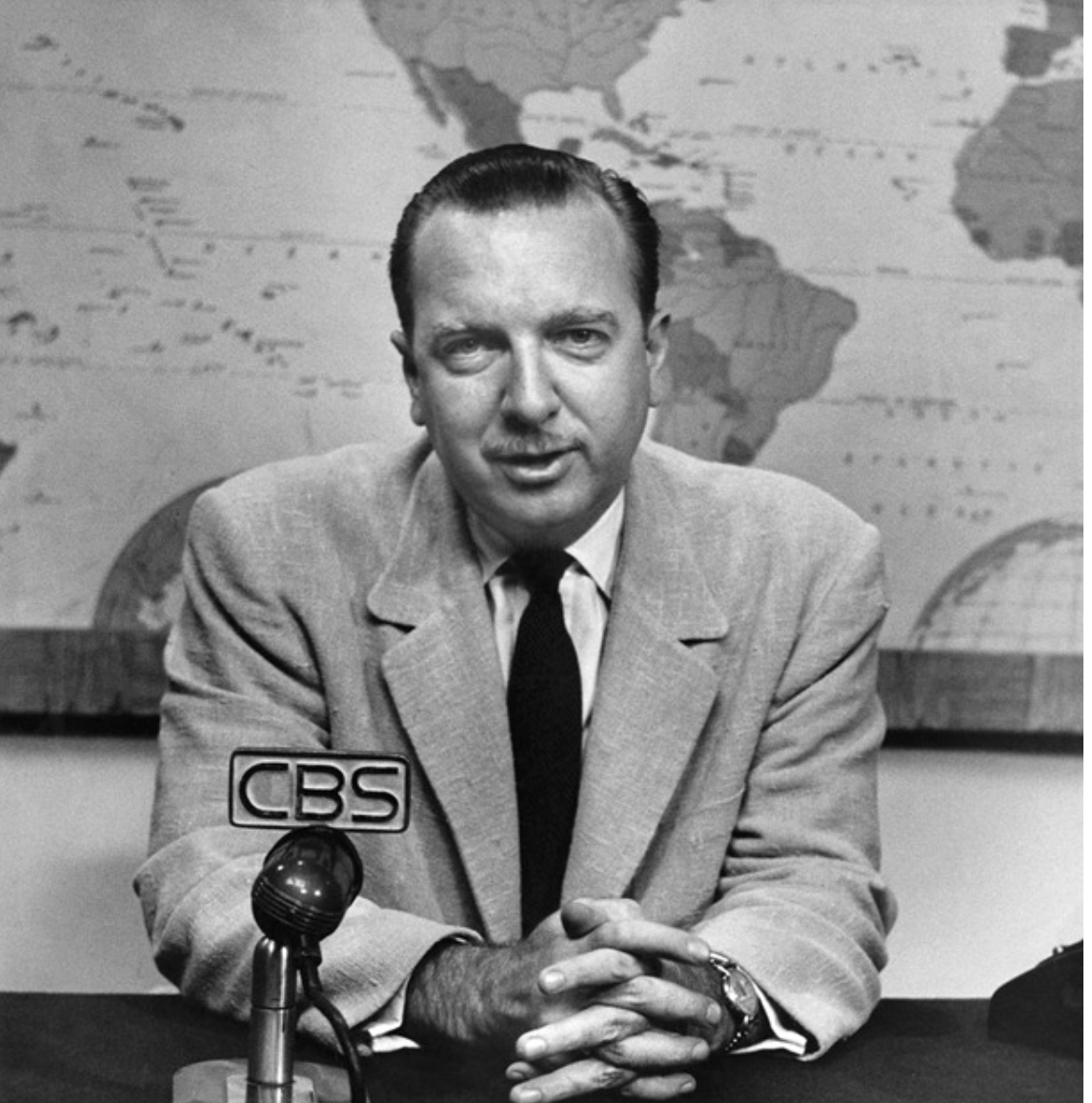
The ostensible focus on the world and actual depiction of North America on the marquee is not meant as a cartographical argument, but echoes the limited concern with other regions or territories in this uncredited map showing the “dependent territories” of the United States, from a classic 1904 manual of American history, which similarly foregrounds the United States as central to a global context and obscures other national boundaries in a uniform gray:
But geographic knowledge was not the point of the De Lauer’s logo or marquee, so much as the comprehensiveness of their stock; De Lauer’s concentrated on all the nation’s newspapers, if it also expanded to include a range of those world-wide, in a gesture of cosmopolitanism of the city, and a complement to the grandeur of the Tribune tower, constructed in 1923 after Renaissance Venice’s bell tower of St. Mark’s–as UC Berkeley’s Campanile–as if to echo the grandiosity of claims to empire on the sea, and is inflected with a distinctive Moorish style. But the grandiosity of the terra cotta apex of the Tribune Tower suggests the bold design of the storefronts of older buildings in Oakland’s once-grand downtown, several buildings of which are adorned by arte nouveau reliefs.
(The sense of Oakland as news entrepot was even more evident in the previous if less majestic tower on the building that resembled a transmission tower and recalled the early role of radio, long before broadcast news:
The subsequent expansion of the 20-story tower added to the building in 1923 reflected gave it a more elegant sense of keeping time for downtown.)
The newspaper store had grown rom a single outdoors newsstand, first moving into the Tribune Press building on 12th Street, the expanded 1301 Broadway store housed a wide range of papers and magazines, complemented by books, postcards, school supplies, maps, cigarettes, energy drinks and souvenirs, a repository of the news and arcade of daily communications from the newswires more than a 5 & dime store. De Lauer’s oddly became a bit of an intellectual hangout by the 1970s as a site of leftist magazines. From the 1970s to 1980s, the illuminated marquee on Broadway was a sort of beacon of world-wide news sources and foreign magazines within Old Oakland’s downtown–where newspaper offices are still clustered in the city, encompassing the world’s news and leftist reviews, and, before the accessibility of world-wide news sources in online form, selling to a wide range of folks and providing a sense of open-ness which perhaps later led the store to permit homeless to camp out by its windows’ permanent 24-hour glow.
Newspaperman Charles DeLauer had worked tirelessly at the stand seven days a week until his tragic death at age 91–committed to providing out-of-town newspapers, racing forms, and foreign as well as national magazines twenty four hours a day, even weathering a declining market for news and the rise of cable news, and, back in the past, the rise of USA TODAY, which featured its own newspaper kiosks and dispensaries on American sidewalks, looking like a familiar television set as a trusted news source. If the market for many were killed by the internet, the building consolidated in downtown Oakland a family business that had once represented some forty newsstands and wagons across the Bay Area–a Bay Area far reduced in size from the present. It has long earned praise for surviving an era of news streams and digital feeds, as well as latching its revenues to glosser magazines and a source for hard-to-locate newspapers for migrants, although its now better known for illuminating the transsexual prostitutes who stand beneath the bright lights of a distinctive gleam, after the downtown neighborhood seems to shut down.
The landmark was rumored to be threatened with closure in 2008. It was saved for a reprieve by an Oakland non-profit, but by he had reached his nineties the aging De Lauer was overwhelmed with fears that the time had come to close the curtains on a store from which over three hundred papers once circulated: “This is a business that time is passing by because everybody has a computer,” he observed stoically, fearing the end of viability of his Catholic commitment to print. As rumors circulating it was shuttered and provoked an outpour of support, just a month before the already retired De Lauer died of lymphoma and leukemia, the shop stocking 300 newspapers was bought by Citrine Advisors, and the store remains afloat, doing a brisk business of not only cigarettes but triangular cello-wrapped tuna fish sandwiches and soft drinks, energy drinks, adult magazines, paperbacks on world history–and range of local and state maps.
The wonderfully retro imprecise confident cartographical crest De Lauer’s long boasted illuminated Broadway twenty four hours a day, by the Civic Center BART, was never so much an actual map. It was an emblem that celebrated the promise of an all-embracing information center of the world before the world wide web, content stored not online but in the magazine racks of the old print arcade; the sign declares the United States to be the information center of the world, and the world as existing and refracted through the United States American Press Corps–contemporary to the Pan Am logo, the global map, designed just before the Cuban Missile Crisis, as an image of global dominion punctured by panic about Soviet missiles once about to be located on that island–an island notably absent from the map on the Super News Stand’s storefront.
The departure of that map, once so central to the store’s public image, in recent years has removed it to a lost Oakland, and left the place once adorned by its the map, now sadly stripped of marquee and only an abandoned wall–the store’s name appearing only as a decal on the window–

–reduced to geometric shapes, as if yet another casualty of the internet economy, which has transformed the storefront into only a Mecca for glossy magazines.


